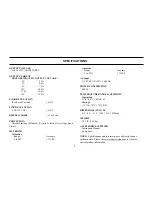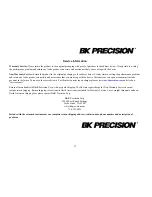
19
TEST INSTRUMENT SAFETY
(continued from inside front cover)
4.
If possible, familiarize yourself with the equipment being tested and the location of its high voltage points. However, remember that high voltage may
appear at unexpected points in defective equipment.
5.
Use an insulated floor material or a large, insulated floor mat to stand on, and an insulated work surface on which to place equipment; and make certain
such surfaces are not damp or wet.
6.
Use the time-proven “one hand in the pocket” technique while handling an instrument probe. Be particularly careful to avoid contacting a nearby metal
object that could provide a good ground return path.
7.
When testing ac powered equipment, remember that ac line voltage is usually present on some power input circuits such as the on-off switch, fuses,
power transformer, etc. any time the equipment is connected to an ac outlet, even if the equipment is turned off.
8.
Some equipment with a two-wire ac power cord, including some with polarized power plugs, is the “hot chassis” type. This includes most recent
television receivers and audio equipment. A plastic or wooden cabinet insulates the chassis to protect the customer. When the cabinet is removed for
servicing, a serious shock hazard exists if the chassis is touched. Not only does this present a dangerous shock hazard, but damage to test instruments or
the equipment under test may result from connecting an earth ground lead of a test instrument to a “hot chassis”. To make measurements in “hot
chassis” equipment, always connect an isolation transformer between the ac outlet and the equipment under test. The
B+K Precision
Model TR-110 or
1604 Isolation Transformer, or Model 1653 or 1655 AC Power Supply is suitable for most applications. To be on the safe side, treat all two-wire ac
powered equipment as “hot chassis” unless you are sure it has an isolated chassis or an earth ground chassis.
9.
B+K Precision
products are not authorized for use in any application involving direct contact between our product and the human body, or for use as a
critical component in a life support device or system. Here, “direct contact” refers to any connection from or to our equipment via any cabling or
switching means. A “critical component” is any component of a life support device or system whose failure to perform can be reasonably expected to
cause failure of that device or system, or to affect its safety or effectiveness.
10.
Never work alone. Someone should be nearby to render aid if necessary. Training in CPR (cardio-pulmonary resuscitation) first aid is highly
recommended.


































